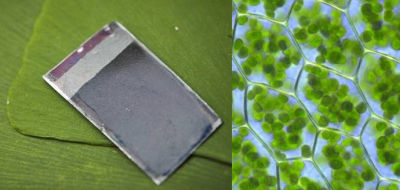During the 1970’s energy crisis, Daniel Nocera became interested in the chemistry of plant photosynthesis as the best source of energy. Most of society’s energy derives from photosysnthesis, stored chemically in plant cells. Eating plants or animals that ate plants provides personal energy, and up to this point, industrial energy has come from the stored sunlight of fossil fuels. Nocera decided that the best long-term energy solutions would be plant based. By 2011, he felt his understanding of plant chemistry sufficiently enabled him to replicate solar energy conversion as performed by vegetation. Nocera unveiled his artificial leaf, “a cheap, playing-card-size coated-silicon sheet that, when placed in a glass of tap water and exposed to sunlight, split the water into hydrogen and oxygen”. This process released the hydrogen (H2) for use as a fuel.
The implications of the artificial leaf are that water could be a ready source of fuel. Methods to electrochemically split water into hydrogen and oxygen by electrolysis have been around for a long time, but mostly rely on fossil generated electricity to do it. Renewable energy electrolysis is also being done, but requires sophisticated and expensive solar panels or wind generators. The artificial leaf is simpler than these technologies. Rather than electrodes in water connected to an external source of electricity, the artificial leaf makes its own electricity while submerged, directly generating hydrogen (H2).
Another big hurdle for electrolysis is that water’s chemical bond resists molecular rearrangement. To overcome this, expensive methods are tpically needed such as increased voltage, adding chemicals, or using catalysts. After several experiments, Nocera and his colleagues used plentiful and cheap cobalt, suplemented with a phosphate buffer. Unanticipated, the cobalt and phosphate had combined on their own into a highly effective, low-cost catalyst, which coated the electrode. Nocera’s catalyst was self-generating, and re-formed after decomposing during the process. They had discovered a regenerative electrolysis – the artificial leaf. Beyond being a one-stage hydrogen generator made from cheap materials, the other huge attribute is that swarms of tech support aren’t needed around the world to maintain the technology.
All this means that the artificial leaf can provide energy independence to everyone everywhere. Nocera’s goal from the beginning has been to provide inexpensive low-tech energy for the billions of impoverished people of the world. Cheap materials and extremely low maintenance does just that. What might be considered the down-side is that it operates at minimal power level, but enough for sufficiency lifestyles. “Nocera’s vision for the world’s poorest people is of a gridless, decentralized energy system, in which every dwelling has an artificial leaf on its roof. When the sun shines, the leaf splits water, about a litre and a half per day, and after dark the residents burn the hydrogen in an inexpensive micro-turbine, which generates electricity till dawn at an average rate of about a hundred watts”. This quantity of hydrogen doesn’t need expensive high-pressure tanks, but can be stored in ordinary metal tanks, at modest pressure.
The artificial leaf doesn’t pack a punch. It doesn’t lend itself to making H2 in quantities for high pressure storage that can power a Tesla Roadster from zero to 140mph in 9 seconds. It’s not for what Nocera calls the “legacy world”, the fortunate minority of the earth’s population who live consumptive lifestyles exploiting fossil fuels and other inhabitants. The artificial leaf is a technology that operates at a solar pace for people living on a solar budget. “The poor are helping you”, Nocera told an audience in Aspen, “because they’re going to teach you how to live for the future”. Read more at – Daniel Nocera’s Artificial Leaf.


Recent Comments